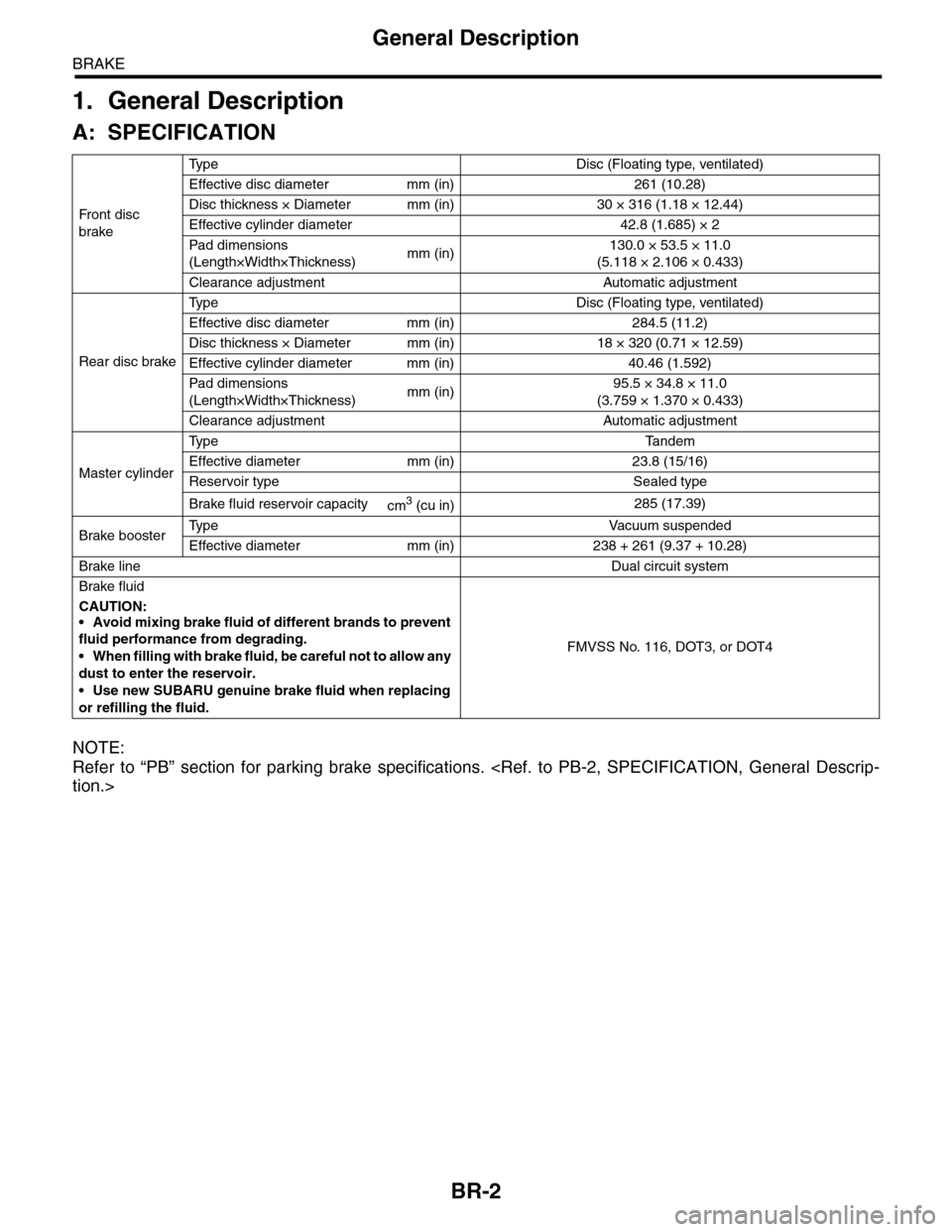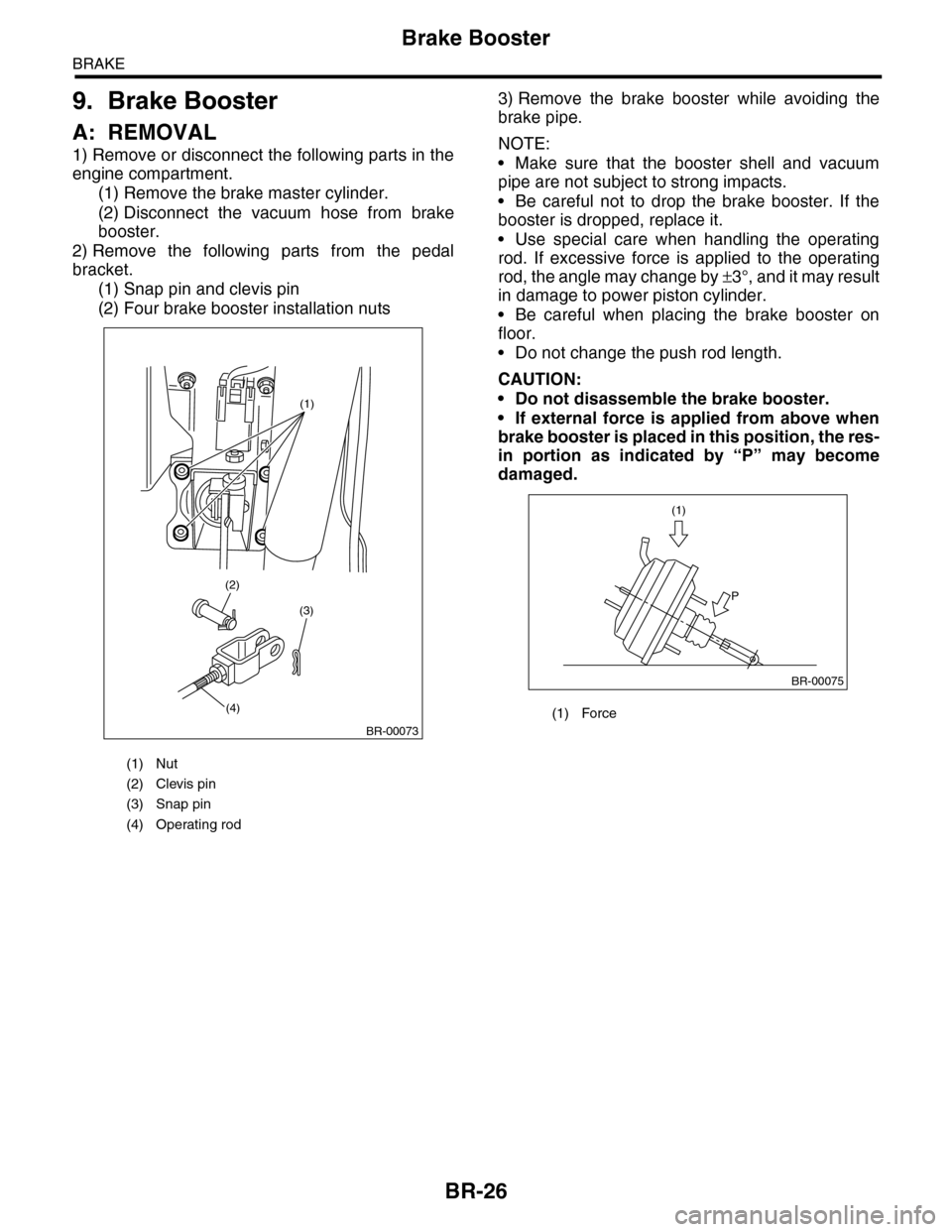Page 716 of 2453

BR-2
General Description
BRAKE
1. General Description
A: SPECIFICATION
NOTE:
Refer to “PB” section for parking brake specifications.
tion.>
Fr o nt d is c
brake
Ty p e D i s c ( F l o a t i n g t y p e , v e n t i l a t e d )
Effective disc diameter mm (in) 261 (10.28)
Disc thickness × Diameter mm (in) 30 × 316 (1.18 × 12.44)
Effective cylinder diameter 42.8 (1.685) × 2
Pad dimensions
(Length×Width×Thickness)mm (in)130.0 × 53.5 × 11.0
(5.118 × 2.106 × 0.433)
Clearance adjustment Automatic adjustment
Rear disc brake
Ty p e D i s c ( F l o a t i n g t y p e , v e n t i l a t e d )
Effective disc diameter mm (in) 284.5 (11.2)
Disc thickness × Diameter mm (in) 18 × 320 (0.71 × 12.59)
Effective cylinder diameter mm (in) 40.46 (1.592)
Pad dimensions
(Length×Width×Thickness)mm (in)95.5 × 34.8 × 11.0
(3.759 × 1.370 × 0.433)
Clearance adjustment Automatic adjustment
Master cylinder
Ty p e Ta n d e m
Effective diameter mm (in) 23.8 (15/16)
Reservoir type Sealed type
Brake fluid reservoir capacitycm3 (cu in)285 (17.39)
Brake boosterTy p e V a c u u m s u s p e n d e d
Effective diameter mm (in) 238 + 261 (9.37 + 10.28)
Brake lineDual circuit system
Brake fluid
CAUTION:
•Avoid mixing brake fluid of different brands to prevent
fluid performance from degrading.
•When filling with brake fluid, be careful not to allow any
dust to enter the reservoir.
•Use new SUBARU genuine brake fluid when replacing
or refilling the fluid.
FMVSS No. 116, DOT3, or DOT4
Page 720 of 2453
BR-6
General Description
BRAKE
3. MASTER CYLINDER
(1) Cap (6) Secondary piston (11) O–ring
(2) Filter (7) Cylinder body
(3) Reservoir tank (8) Cylinder pinTightening torque: N·m (kgf-m, ft-lb)
(4) C-ring (9) SealT: 25 (2.5, 18.4)
(5) Primary piston (10) Pin
BR-00492
T
(1)
(2)
(3)
(7)
(8)
(9)
(10)
(4)(11)
(5)
(6)
Page 721 of 2453
BR-7
General Description
BRAKE
4. FRONT BRAKE PIPES AND HOSE
(1) Front brake pipe ASSY (6) GasketTightening torque: N·m (kgf-m, ft-lb)
(2) Two-way connector (7)
VDC control module and hydraulic
control unit (VDCCM&H/U)
T1: 15 (1.5, 10.8)
(3) Front brake hose RHT2: 18 (1.8, 13.0)
(4) Front brake hose LH (8) BracketT3: 19 (1.9, 14.0)
(5) Clamp (9) Master cylinderT4: 33 (3.4, 24.3)
BR-00493
T1
T2
T4
T2
T2
T2
T4
T1
T3
(8)(2)
(3)
(5)
(6)
(4)
(7)
(6)
(5)
T3
T1
T1
(1)
(9)
T1
Page 731 of 2453

BR-17
Front Disc Brake Assembly
BRAKE
C: DISASSEMBLY
1) Remove mud and foreign matter from the caliper
body assembly and support.
CAUTION:
Be careful not to allow foreign matter to enter
the brake hose connector.
2) Place a wooden block in the caliper body as
shown in the figure to prevent the piston from jump-
ing out and being damaged.
3) Gradually apply compressed air via the brake
hose installation hole to push the piston out.
4) Remove the piston boot.
5) Remove the piston seal from caliper body cylinder.
CAUTION:
Do not damage the cylinder and piston seal
groove.
6) Remove the guide pin and boot from caliper body.
D: ASSEMBLY
1) Clean the inside of the caliper body using brake
fluid.
2) Apply a coat of brake fluid to piston seal and in-
stall piston seal in the groove on caliper body.
3) Apply a coat of brake fluid to the inner surface of
cylinder and the entire outer surface of the piston.
4) Apply a coat of specified grease to the boot, and
fit to the groove on the ends of the cylinder.
Grease:
NIGLUBE RX-2 (Part No. K0779GA102)
5) Insert the piston into cylinder.
CAUTION:
Do not force the piston into cylinder.
6) Position the boot in the grooves on cylinder and
piston.
7) Apply a coat of specified grease to the lock pin
and guide pin outer surface, cylinder inner surface,
and boot grooves.
Grease:
NIGLUBE RX-2 (Part No. K0779GA102)
(1) Place a wood block of 30 mm (1.18 in) width.
(1) Piston seal
(1)BR-00026
BR-00240
(1)
BR-00027
(1) Piston
(2) Piston boot
(1) Piston
(2) Piston boot
(3) Caliper body
(4) Piston seal
BR-00242
(1)
(2)
BR-00243
(1)
(2)
(3)
(4)
Page 737 of 2453

BR-23
Rear Disc Brake Assembly
BRAKE
4) Remove the piston seal from caliper body cylin-
der.
CAUTION:
Do not damage the cylinder and piston seal
groove.
5) Remove the lock pin sleeve and boot from cali-
per body.
6) Remove the guide pin boot.
D: ASSEMBLY
1) Clean the inside of the caliper body using brake
fluid.
2) Apply a coat of brake fluid to piston seal and in-
stall piston seal in the groove on caliper body.
3) Apply a coat of brake fluid to the inner surface of
cylinder and the entire outer surface of the piston.
4) Apply a coat of specified grease to the boot and
fit to the groove on the ends of cylinder.
Grease:
NIGLUBE RX-2 (Part No. K0779GA102)
5) Insert the piston into cylinder.
CAUTION:
Do not force the piston into cylinder.
6) Position the boot in the grooves on piston and
cylinder.
7) Apply a coat of specified grease to the guide pin,
outer surface, sleeve outer surface, cylinder inner
surface, and boot grooves.
Grease:
NIGLUBE RX-2 (Part No. K0779GA102)
8) Install the guide pin boot to the support.
9) Install the lock pin boot to support, and then in-
sert the lock pin sleeve into the specified position.
E: INSPECTION
1) Repair or replace the faulty parts.
2) Check the caliper body and piston for uneven
wear, damage or rust.
3) Check the rubber parts for damage or deteriora-
tion.
(1) Piston
(2) Piston boot
(3) Caliper body
(4) Piston seal
BR-00043
BR-00243
(1)
(2)
(3)
(4)
(1) Pin boot
(2) Lock pin or guide pin
(3) Grease applied area
BR-00362
(1)(2)
: (3)
Page 738 of 2453

BR-24
Master Cylinder
BRAKE
8. Master Cylinder
A: REMOVAL
CAUTION:
Do not allow brake fluid to come in contact with
vehicle body. If it does, wash off with water and
wipe away completely.
1) Drain brake fluid from the reservoir tank com-
pletely.
2) Disconnect the harness connector of the fluid
level gauge.
3) Remove the brake pipe from the master cylinder.
4) Remove the master cylinder mounting nuts, and
remove the master cylinder from the brake booster.
B: INSTALLATION
1) Install in the reverse order of removal.
Tightening torque:
Master cylinder mounting nut
25 N·m (2.5 kgf-m, 18.4 ft-lb)
Brake pipe
19 N·m (1.9 kgf-m, 14.0 ft-lb)
CAUTION:
Be sure to use recommended brake fluid.
2) Bleed air from brake system.
PROCEDURE, Air Bleeding.>
C: REPLACEMENT
1) Remove mud and dirt from the surface of brake
master cylinder.
2) Secure the master cylinder in a vise.
NOTE:
To avoid damaging the master cylinder, place be-
tween aluminum plates or other material when
holding with a vise.
3) Remove the pin which secures the master cylin-
der and reservoir tank, then remove the reservoir
tank and seal.
4) While pushing in the primary piston, remove the
C-ring using pliers.
5) While pushing in the primary piston, remove the
straight pin from the port on the reservoir tank at-
tachment location using a magnet pick-up tool.
6) Extract the primary piston assembly and sec-
ondary piston assembly straight out while taking
care not to scratch the inner surface of the cylin-
ders.
7) Clean the inside of master cylinder with brake
fluid. Check the inside of the cylinder for damage,
deformation and wear. Replace the master cylinder
as assembly if faulty.
8) Apply brake fluid to the inner surface of master
cylinder and piston assembly.
9) Make sure that the inner surface of master cylin-
der and the piston assembly are free of foreign
matter. Install the primary piston assembly and the
secondary piston assembly to master cylinder,
while taking care not to scratch the master cylinder
inner surface.
10) While pushing-in the primary piston, install the
cylinder pin.
BR-00499
(1) Straight pin
BR-00169
(1)
BR-00069
Page 739 of 2453
BR-25
Master Cylinder
BRAKE
11) While pushing-in the primary piston, install the
C-ring to the groove using pliers.
CAUTION:
Make sure the C-ring is installed to the groove
securely.
12) Install the seal to reservoir tank.
13) Install the reservoir tank to the master cylinder,
and secure with pin.
D: INSPECTION
Inspect for oil leakage from the master cylinder.
NOTE:
After replacing the piston kit, if an oil leakage is
found even though there is no damage or scratches
on the inside of the cylinder, the master cylinder in-
ner wall may be worn. In this case, replace the
master cylinder as an assembly.
(1) Seal
BR-00169
(1) BR-00072
Page 740 of 2453

BR-26
Brake Booster
BRAKE
9. Brake Booster
A: REMOVAL
1) Remove or disconnect the following parts in the
engine compartment.
(1) Remove the brake master cylinder.
(2) Disconnect the vacuum hose from brake
booster.
2) Remove the following parts from the pedal
bracket.
(1) Snap pin and clevis pin
(2) Four brake booster installation nuts
3) Remove the brake booster while avoiding the
brake pipe.
NOTE:
•Make sure that the booster shell and vacuum
pipe are not subject to strong impacts.
•Be careful not to drop the brake booster. If the
booster is dropped, replace it.
•Use special care when handling the operating
rod. If excessive force is applied to the operating
rod, the angle may change by ±3°, and it may result
in damage to power piston cylinder.
•Be careful when placing the brake booster on
floor.
•Do not change the push rod length.
CAUTION:
•Do not disassemble the brake booster.
•If external force is applied from above when
brake booster is placed in this position, the res-
in portion as indicated by “P” may become
damaged.
(1) Nut
(2) Clevis pin
(3) Snap pin
(4) Operating rod
(1)
(3)
(4)
(2)
BR-00073
(1) Force
(1)
P
BR-00075